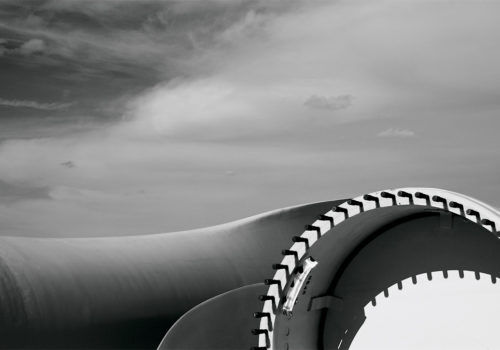Photographer Jay Tyrrell vividly remembers watching War of the Worlds in a big theater when he was a boy. The 1898 book War of the Worlds is considered one of the first science fiction novels; its 1938 radio broadcast created unintended pandemonium among listeners who didn’t realize its “Earth invaded by aliens” plot was fiction, and when the 1953 film adaptation hit theaters, its imagery quickly embedded itself in the American psyche.
Now, more than a century since H.G. Wells first published this repeated catalyst for media innovation, Tyrrell is paying homage to it with Wind Army, his own re-imagining of “the photo book.” Tyrrell’s eerie black-and-white images of wind turbines were spurred by his childhood memories of alien “tripods” marching on Earth’s helpless forces. In his multimedia VOOK (video-book), available as an iPad app, he combines these photos with rare historical elements inspired by War of the Worlds, including a video, comics, and the full-length original radio broadcast.
Tyrrell has decided to donate all proceeds from his VOOK’s sale to the collectors’ group at the Santa Barbara Museum of Art, near his home. Three photographs from Wind Army will be on view at the museum’s Recent Acquisition wall until February 26, 2012, with a larger presentation of photographs in the works.
Below, Tyrrell remembers his first time seeing War of the Worlds, and his own perspective on media and storytelling innovation.
What do you remember about seeing War of the Worlds in the theater?
Movies were very new to me in 1953 and, until that time, they consisted of topics bland by even today’s G-rated standards. So watching Earth being attacked from outer space by aliens was startling; the color, imagery, and subject, very intense. My family was stationed in Germany as “guests” of the U.S. Army then, which probably heightened my awareness of the role the military played in humans’ futile attempts to stop the Tripods. I can remember the Flying Wing being deployed, and the disappointment that even that was unable to stop them. It was almost anti-climatic when it was finally Earth’s own microbes and viruses that won the day.
Why was it important for you that this project move beyond traditional ideas of “a book” or “an exhibition”?
I knew that I wanted this body of work to end up as more than just a pile of prints. Because so many mediums had already already employed W.O.W. to create (in their time) new and innovative creations, it seemed natural to combine them using today’s new media platforms, and curate them into my own statement. I initially chose the e-book format with Adobe Reader as the platform, and as the project progressed, the iPad exploded onto the scene. I knew immediately that this would be an ideal platform for the project. I had read about VOOK in the New York Times, and when I finished the Adobe version, I drove to their offices in Alameda, barged in, and showed them my project. They took it on and converted the Adobe version into the app currently available in the iTunes store.
Why did you decide to donate the proceeds from the project to SBMA?
I had realized early on that if I was going to gain permission to use other W.O.W. material, having a for-profit end-product was too complicated. It was more important to me that the project have access to the radio broadcast, movie, and comics associated with W.O.W., so I decided to donate the project. Karen Sinshiemer, the curator of photography at the Santa Barbara Museum of Art, had been an enthusiastic supporter of the project, so I approached her to see if the museum was interested in adding my photographs to their collection and receiving a donation from the proceeds of the e-book and, eventually, the VOOK app. They were the perfect partner.
Miki Johnson
Wind Army
Jay Tyrrell
Until February 26, 2012
Santa Barbara Museum of Art
1130 State Street
Santa Barbara
California
















